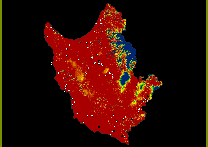Conclusions
A review of the literature has shown that limitations are present in predictive archaeological modeling and it is certainly the case that the model presented here could be significantly improved, most notably with a wider range of datasets which are of better resolution.
It has been shown that a DST model can easily incorporate new lines of evidence which can advance the model so improved data collection and sampling is an important aim. However it is hoped that analysis with DST of the available data layers has shown that results can be generated which provide useful information for identifying areas of low and high probability for archaeological sites and those areas which still need further investigation.
This may not be the aim for every user of such a model but for the area of cultural heritage management it will be of primary concern. The advancement of a primary model such as this with continued renewal incorporating fresh data could be an important tool for those responsible in preserving the archaeological heritage of Cyprus.
Whilst excavations are necessary to better quantify results and address social questions modeling could provide planners with the required knowledge to help prioritise areas for investigation.
Predictive modeling may hold the key to the preservation of archaeological sites under threat in Cyprus. The ability of these models to highlight the areas of greatest archaeological potential could be of great benefit to the cultural management organisations of Cyprus, allowing them to quickly assess areas under threat and act accordingly to guarantee the preservation of Cypriot cultural heritage for future generations.



